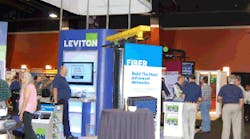Held from September 18-22 at the MGM Grand Hotel & Convention Center in Las Vegas, the BICSI 2011 Fall Conference attracted nearly 3,800 attendees, exhibitors, and visitors. Industry professionals had an opportunity to find out what lies ahead in the areas of education technology, data centers, electric power/energy efficiency, codes and standards, mobile and wireless applications, design/construction software, and more.
Industry Trends
The acceptance of modular data centers has changed the economic model of construction and operation for these vital services. Many organizations are taking the initiative to create greener data centers; however, LEED certification is going to be harder to attain for these facilities because of ASHRAE 90.1, 2010 and California’s Title 24 requirements — as the need for high volume storage increases. One benefit is that pre-terminated fiber-optic systems are helping to speed construction and allowing for increased density in the equipment and cross-connect racks and enclosures.
Administration of the physical layer in the network infrastructure is gaining greater attention in the IT industry, because care in setting up proper identification and administration of cabling assets can save time and money for the installer and the user. The forthcoming TIA-606-B Administration Standard for Telecommunications Infrastructure, which involves labeling and identification of components, most likely will be backward compatible with the 606-A version and harmonized with the ISO/IEC JTR 1746-3-2-1 standard.
The development of Power over Ethernet (PoE) and PoE Plus systems allows low-voltage DC electric power to be delivered from switches, mid-span units, or PoE-enabled patch panels to conductor pairs of a twisted-pair cable assembly. PoE carrying 30W to 60W can serve new devices, ensuring support for new technologies within a typical commercial office.
The IT professionals at BICSI also learned about lighting technology. A low-voltage lighting system consisting of an isolating type low-voltage power supply operating at 30V or less (Class 2 conductors) can be carried on a twisted-pair cable to a light source — consider the light emitting diode (LED) a practical and efficient light source. Or, the power distribution system can also be installed as part of a suspended ceiling grid that provides mechanical support of the ceiling tiles. This concept fits within the requirements of Art. 411 of the NEC for a lighting system and associated components operating at 30V. Such a low-voltage grid distribution system could also supply AV systems, security systems, occupancy sensors, and other services.
Moving outside the building, BICSI released the 5th edition of its “Outside Plant Design Reference Manual.” Material covered for the first time in this document includes passive optical networks, wireless broadband, intrusion detection, and alarm circuits.
Educational Sessions
On the conference front, speakers of more than 20 educational sessions covered topics ranging from non-compliant cabling products to smart buildings.
In the “Division 27 Specifications and Standards: What to Include and Look for in Your Next Project” presentation, Matthew Peterworth, Information Technology Services, University of Texas, Austin, Texas, noted that a well-written and maintained Division 27 specification can help deliver a successful project. The specs and standards of CSI’s MasterFormat can provide accuracy when designing and installing a low-voltage information transport system serving voice, data and cable TV, along with audio/video, mass notification, distributed antenna systems, and other services. He noted that designers are expected to attend meetings during the programming phase, schematic design, design development, and construction document phases of the project. They also need to provide feedback on submitted bids, evaluate submittals, attend kickoff and construction meetings, respond to RFIs and change-orders, perform inspections, and review test results, record drawings, and close out documents.
In “Noncompliant Cabling Products — How Big is the Problem and What Can Be Done?”, Todd Harpel, Berk-Tek, New Holland, Pa., discussed the growing epidemic of noncompliant communications cabling being sold in the North American market, which claims to meet codes and standards such as NFPA 70 Life Safety Code and TIA-568C.2. These virtually unknown brands are often routed through non-traditional purchasing channels at lower prices. In many cases, the quality-deficient products feature counterfeit labels and markings. The latest effort at reducing material costs in cable construction is the use of copper-plated aluminum conductors, which have less flexibility and may not achieve the signal transmission performance that is expected of the cable.
The Communications Cabling and Connectivity Association (CCCA), an industry organization founded in 2007, has tested samples of cabling from offshore firms that failed applicable fire and flame resistance standards. In a 2010 test of patch cords, all 120 U.S. products passed, while 85% of 379 samples from off-brands failed. Other patch cords issues include substandard gold plating on contacts, inadequate contact spacing and dimensional issues, and not meeting FCC requirements. None of the failing cords showed the use of independent third-party testing labs to verify performance, though patch-cord testing and verification programs are available from a number of testing agencies. According to CCCA, the high failure rates result from using low-quality components, poor assembly methods, and poor quality control. Ongoing efforts by CCCA include advocating tighter quality assurance procedures by independent testing agencies with emphasis on follow-up, training, and educational tools as well as further product testing and monitoring. Initial actions by UL include public notification about unauthorized reference to UL and, in the long term, monitoring a UL Mark Integrity Program.
In the “The 40Gbps Twisted-Pair Ethernet Ecosystem” presentation, Valerie Maguire, Siemon, Watertown, Conn., and Dave Hess, Berk-Tek, New Holland, Pa., looked ahead to the imminent reality of 40- and 100-GB Ethernet balanced twisted-pair copper network. The growth of storage area networks to satisfy the regulatory requirements for the retention of information and the reality of video-centric applications are two of the drivers for these higher-speed systems, which rely on parallel cables. Because Cat. 6 and Cat. 7/7A cabling can be upgraded to carry 40GbE or higher, a significant effort is now underway to solve the technical limitations regarding 40- and 100-GbE transmission over copper cable. Several ideas have been offered for overcoming the problems related to signal processing complexity and developing accurate field test instruments.
In the “The BID Paradigm Shift: The Impact of Manufacturer Production Specification” presentation, Dwayne Miller, IBD Resource Group, Ltd., Las Vegas, and Alex Willingham, Autodesk, Inc., Denver, described the growing importance of this software tool in an era of fast-paced design/build construction. Nearly $16 billion is lost annually because data cannot be accessed and shared in all stages of a project from concept, design, engineering, and construction to facility maintenance and operation. The benefits gained by using this type of software include improved visualization and productivity, increased coordination of construction documents, reduced costs, and faster project delivery. In a BIM environment, general contractors have been allowing subcontractors that use BIM to coordinate their conduit runs and develop their portion of the project first. A number of federal agencies, such as GSA and other government agencies/universities, now require this software for all new construction projects.
In the “2011 National Electrical Code: Major Revisions for Computer Rooms” presentation, Dr. Stanley Kaufman, CableSafe, Inc., Atlanta, and Stephen McCluer, APC by Schneider Electric, Dallas, reviewed many of the significant changes adopted in Art. 645 relating to telecommunications equipment in data centers. The speakers noted that just because there might be IT equipment in a room does not mean the requirements of this article must be applied. The rules of Art. 645 allow for alternate construction from the general wiring requirements found in Chapters 1-4. Changes in wording now make this much clearer than the wording that appeared in the 2008 edition of the Code. A new requirement now makes it clear that no equipment is now permitted in the computer room that is not associated with the operation of the room. Art. 645 does not cover communications circuits, but it does apply to the power wiring for communications equipment. A number of new definitions also help clarify the proper application of the requirements noted throughout this section.
In the “Wireless Trends Driving Demand for Distributed Antenna Systems (DAS)” presentation, Loan Gordon, Loop Marketing, LLC, Redmond, Wash., and Greg Jacobs, Connectivity Wireless Solutions, Duluth, Ga., underscored the increasing application of wireless connectivity within a building. The use of Low-E glass, which reflects infrared energy, in commercial buildings and other structures blocks or attenuates wireless transmission through the windows. An in-building distributed antenna system (DAS) can deliver reliable wireless network technologies at suitable transmission speeds.
In “What AV Products Can I Use,” Eric Marshall, E.R.I.C. Low Voltage Services, Modesta, Calif., followed a four-step method to describe the options available for selecting input sources and choosing either analog or digital delivery services. He also covered the variety of projector units, screens, monitors, and processing equipment available in the market today, along with how to determine screen size and what type/quantity of cables to use on various types of installations.
In the “Understanding the New Wireless Codes” presentation, Jack Daniel, RF Solutions, Victorville, Calif., discussed the regulations being adopted in urban areas where fire and police emergency communications must be maintained within high-rise buildings and other large structures. He noted that typical areas of poor RF coverage include buildings — especially basement areas, subways, mines, parking garages, and naturally shadowed areas (i.e., canyons, behind hills, river bottoms, etc.). He also pointed out how signal strength is reduced when passing through the walls of buildings. According to the 2010 edition of NFPA 72, National Fire Alarm and Signaling Code, no amplification system capable of operating on frequencies or causing interference on frequencies assigned to the jurisdiction by the FCC shall be installed without prior coordination and approval of the AHJ. The building manager/owner shall suspend and correct other equipment installations that degrade the performance of the public safety radio system or public safety radio enhancement system. Additional requirements of this particular code were discussed in detail.
In “Infrastructure Administration with Automated Infrastructure Management (AIM) Systems,” Gene Malone Sr., TE Connectivity, Greensboro, N.C., described the growing importance of cabling system management to reduce the labor expense of maintenance for today’s converged networks. These systems are able to map, monitor, and maintain patch-field connectivity. Recently developed processes, cable management software, and automated technology can identify and track the movement of all assets that attach to the network, giving administrators the ability to see what is connected (and where) at all times. These processes reduce mean time to repair by helping to prevent human error and unauthorized patch field changes, whether deliberate or accidental. The ANSI/TIA-606-B Administration Standard for Telecommunications Infrastructure revision (currently in ballot) is recognizing the capabilities of these systems, which include: 10-wire patch-based, RFID-based, chip-based, and 9th wire continuity-based systems.
Visit the BICSI website (http://www.bicsi.org/fall/2011/attendee.aspx?id=5682) to access the complete PowerPoint presentations of the sessions noted within this article.



